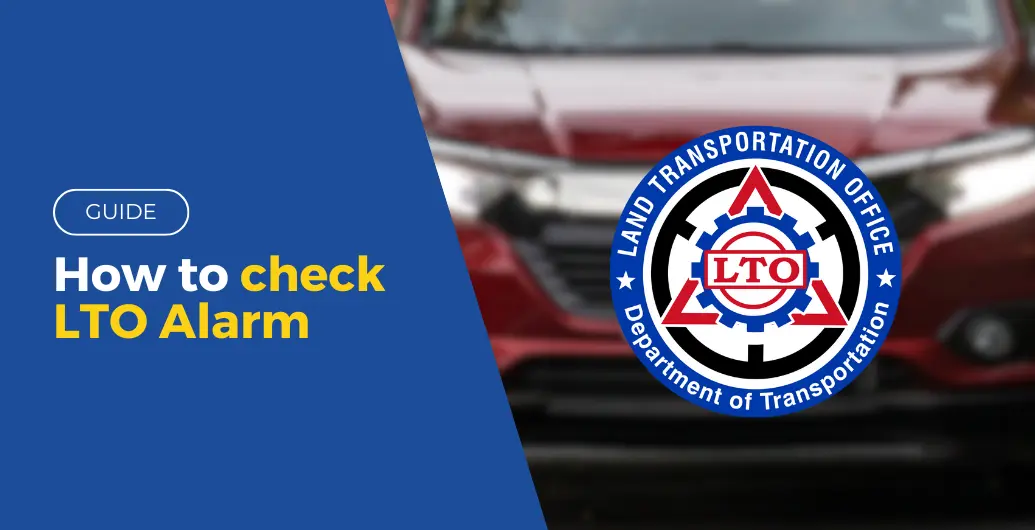To ensure general safety, vehicles in the Philippines have LTO alarm tags, which are active LTO records of existing or pending traffic violations or apprehensions. When a specific vehicle has an alarm tag, they have previous records of violations and even criminal involvement. Additionally, their records are also on the Philippine National Police’s watch list. Specifically, the Highway Patrol Group (PNP – HPG).
On the other hand, vehicles with LTO alarm tags can also have potential violations or cases with other agencies such as the Department of Health (DoH), the Land Transportation Franchising Regulatory Board (LTFRB), or the Internal Investigation Division (IID). So, if you’re wondering how to check your LTO alarm, you are definitely in the right spot.
Table of Contents
How to Check if a Vehicle Has an LTO Alarm Violation
It’s worth noting that there are two ways to identify if a specific vehicle has an alarm tag. It’s through a Vehicle Identification Number (VIN) or accessing LTO’s Mobile Query Facility. Remember that these two ways have different methods so it’s best to take notes of the details and their manual steps to ensure a seamless navigation.
Vehicle Identification Number (VIN)
All of the vehicles come with their respective vehicle identification number (VIN). It contains 17 unique character codes that serve as serial numbers for better identification. The information included in the vehicle are the following:
- Country of manufacture
- Vehicle manufacturer
- Vehicle’s production number
More details will be found in certain places in your vehicle as well. Specifically, a vehicle’s VIN is commonly found under the hood, on the dashboard, and on the driver’s side door pillar. Through the VIN, you’ll see the records of the vehicle’s previous involvement in accidents, repair, and more.
Also Read: GUIDE: How to Get an LTO Conductor’s License
LTO’s Mobile Query Facility
Through the LTO alarm list, individuals have an easier time identifying a specific vehicle through its physical attributes. As a result, they’ll know if the car matches the vehicle they’re looking for. This method contains the following information:
- Plate number
- Make
- Model
- Year of Manufacturing
- Color
- Date Last Registered in LTO
- LTO Apprehension
- Records
- LTO Alarm
If you want to check alarms using the LTO Mobile Query facility, you can simply type “LTO VEHICLE [Plate Number]” and send it to 2600 from any network. Additionally, applicants can expect a response within five to ten minutes. It only costs PHP 2.50 for all cellular networks in the country. However, this system only works during office hours. So make sure you’re active during the day to benefit from this service.
Who Can Avail of the Service?
Anyone accessing relevant information such as VIN or the Plate Number can check alarm tags. However, lifting alarm tags is crucial for drivers or vehicle owners. In addition, individuals planning to purchase vehicles from used car markets are advised to renew their vehicles but can’t due to the LTO alarm tags.
Furthermore, authorities also use this service to look for car owners who are suspected of specific cases. This is also a helpful method for tracing carnapping incidents, especially at police checkpoints.
Requirements to Lift LTO Alarm Tags
You can lift the alarm if you’re a vehicle owner whose newly owned car has been tagged without your involvement. You can do this by submitting the documentary requirements if you want to request a lift for the vehicle’s alarm tags. The requirements are few. However, specific agencies may need additional requirements. People should ensure that they’ll be able to take note of these requirements.
- Original letter request addressed to the Director of Traffic Adjudication Service (TAS)
- Any valid Government issued ID/Deed of Sale (if not the registered owner)
- Original Special Power of Attorney (if representative)
Also Read: GUIDE: LTO Theoretical Driving Course
Additional Requirements
In some cases, agencies like PNP-HPG, Department of Health (DOH), Land Transportation Franchising Regulatory Board (LTFRB), or Internal Investigation Division (IID) may require individuals additional requirements such as:
- Original letter request to lift alarm from the investigator
- Original Affidavit of Desistance
- Original Philippine National Police – Highway Patrol Group (PNP-HPG) Letter of endorsement
- Original Official Receipt (OR) / Certificate of Registration (CR) of the motor vehicle or certified true copy of the same from the issuing agency.
- Original Philippine National Police – Highway Patrol Group (PNP-HPG) Recovery and Disposition Report
- Original Philippine National Police – Highway Patrol Group (PNP-HPG) Crime Laboratory Marco – Etching Report
- Original Philippine National Police – Highway Patrol Group (PNP-HPG) MV Clearance
- Original duly accomplished Land Transportation Office (LTO) Motor Vehicle Inspection Report
For DOH, here are the following:
- Original Confirmatory Test
- Original Medical clinic letter of Endorsement
Both LTFRB and IID, on the other hand, require the same document:
- Original Resolution to lift alarm
Final Thoughts
Alarm tags are crucial components of vehicles. Tracing the vehicle’s records can be easy and convenient, especially if they’re involved in serious crimes or issues. However, identifying LTO alarm tags may require specific requirements and steps to have seamless access to both methods mentioned above.
Furthermore, it’s best to inquire with any officer from the mentioned agencies to ensure you follow the right ways and requirements. You can start by visiting their website to gather insights about their contact details.
Keep Reading: GUIDE: Where to Get a Medical Certificate for LTO in 2023?

Leave a Reply